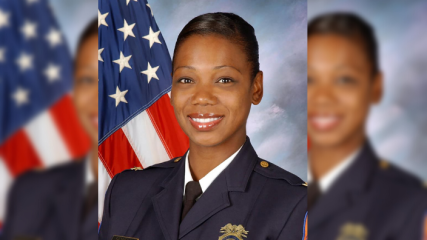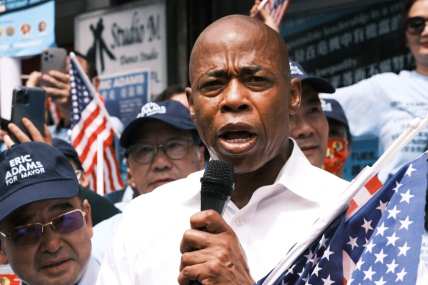Can the new police commissioner bring real change to the NYPD?
OPINION: Keechant Sewell makes history as the first woman to lead the department, but she faces many challenges to fixing a police force that is resistant to changing its ways.
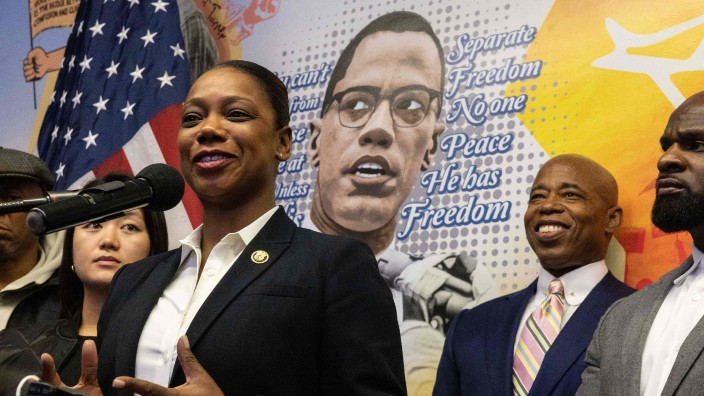
On Wednesday, New York City Mayor-elect Eric Adams announced his historic appointment of Nassau County Chief of Detectives Keechant Sewell as the first woman and third African-American to lead the nation’s largest police department at Long Island City’s Queensbridge Houses, the projects where she grew up.
Moments after reporters posted the first pictures of the event, the twitterverse went off—not at Sewell’s appointment, but at the wall mural behind the podium where Adams and Sewell stood, which featured prominent portraits of Malcolm X, Angela Davis, Nat Turner, Huey Newton and the still-fugitive and living in Cuba radical, Assata Shakur.
“Well, this doesn’t bode well,” wrote @RyanGirdusky.
“A wall of people he would have planted evidence on” tweeted @egoldmanrevolt.
“Never before seen levels of disgusting co-option” wrote @Plz_Relax.
“It won’t do any good! A Black Lib in charge won’t keep the Blacks from killing each other, I’ll bet he will make it worse!” said @Louis122757.
“SHOCKING AND REPULSIVE” wrote former NYC police commissioner and current Newsmax commentator Bernard Kerik, who I interviewed in the Federal Correctional Institute in Cumberland, Md., while he was doing four years for tax fraud and lying to officials. “The black radical Marxists in this mural belonged to groups that were responsible for a number of #NYC Police assassinations in the 70s and 80s. Assata Shakur, the inspiration for #BLM and a convicted cop killer, lives in exile in Cuba” Kerik said.
And so it begins.
What will undoubtedly be one of the most compelling and emotionally taxing four years in modern New York City history kicks off Jan. 1 when Adams, a former NYPD captain, takes the oath of office at Brooklyn’s Kings Theatre, and Sewell takes the reins of the NYPD’s 55,000 employees, 36,000 armed officers among them.
“As police commissioner, I carry out the vision articulated by Mayor-elect Adams, enhanced by the inclusion of people and partners who are doing the work on the ground,” Sewell said at the presser, showing ready support for a variety of Adams’ proposals, including the controversial return of plain-clothed undercover officers and the use of the controversial stop and frisk.
Sewell said she is “100 percent for transparency and accountability” in the department and vowed to have her officers’ backs “but they have to have the backs of the public. I will hold my officers accountable, and I know they will do the same to me.”
The two announced a daring plan to deliver a variety of services, including food and mental health services at or near local police precincts, potentially keeping thousands of people of color out of the criminal justice system.
These are revolutionary proposals for the NYPD—and perhaps why Adams saw fit to make the announcement where he did, suggesting a change in how the NYPD will interact with its Black and brown residents—with community-based strategies combined with traditional policing, all led by Sewell.
The NYPD is one of the most powerful, well-armed quasi-military groups in the world, owner of armored personnel carriers, a fleet of submarine drones, and surveillance vans that can drive by a car and scan it for explosives. Former Police Commissioner Ray Kelly once bragged that the department could shoot down a plane.
But the NYPD, like the city and nation, is in the midst of a racial reckoning. As the New York Times notes, Sewell will be tasked with diversifying the department, which has improved its recruitment among Hispanics and Asians, but Blacks are still only 15 percent of the force in a city that is 25 percent Black. Women account for 19 percent of the police force, according to the Civilian Complaint Review Board, the agency charged with investigating charges against police. And, of course, the department’s leadership is mostly white and male.
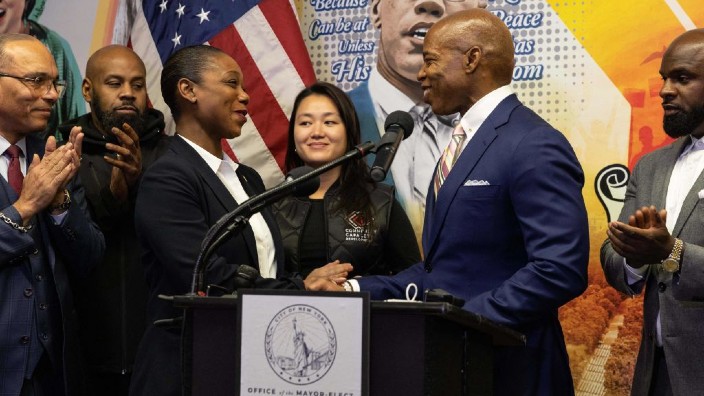
Patrick Lynch, president of the powerful Police Benevolent Association, the police union that does collective bargaining with the city, endorsed former President Donald Trump last year without consulting the membership. He has also been very vocal in his opposition to calls for reforming the NYPD.
Black leaders have long criticized the NYPD for its casual use of deadly force against Black victims—Amadou Diallo, Eleanor Bumpurs, Patrick Dorismond, Eric Garner and Akai Gurley, to name a few—and for not punishing officers who kill them.
It didn’t help the NYPD’s image to see cops driving squad cars into Black Lives Matter demonstrators during the daily protests following the death of George Floyd, or to watch an officer stroll over and casually knock over a white girl standing on the sidewalk who was not even a demonstrator.
In 2021, even minor racial interactions in America are viewed like Rorschach tests— people see what fits their agenda.
The mural on the wall of the community room of the public housing project where the next New York Police Department commissioner grew up had nothing to do with what the mayor-elect and commissioner had to say.
But that’s all too many folks saw—offering a glimpse of the many doubts and challenges Sewell faces as she takes the reins of the department and tries to steer it in the direction Adams has set.
Adams ran and won on a centrist platform, one that promised a little something to everybody. His pledge to bring down crime while both reforming and supporting the police attracted big-money donors from well outside his home borough of Brooklyn and even earned him an endorsement by Rupert Murdoch’s archconservative New York Post.
But the problem with the middle ground is you have an equal chance to upset everybody.
Crime is a thorny issue everywhere, even more so in New York City where the NYPD only seems to release security camera footage of Blacks and Hispanics committing crimes. Adams has promised to reinstate plainclothes undercover police operations, and to ramp up the dreaded “stop and frisk,” under which cops executed some 685,724 stops at the program’s 2011 peak. The vast majority of those stopped were Black and Hispanic.
Adams and Sewell ignored a heckler at the presser who asked why they were bringing back the controversial tactic.
With Sewell, the mayor-elect clearly wants to claim the middle ground on all public-safety issues—he repeated his claim of wanting to close the troubled Rikers Island prison, where 14 prisoners have died in custody so far this year. But later, when announcing Louis Molina as his new city Corrections Department commissioner, Adams said he would support using solitary confinement for violent inmates, an abomination for prison-reform advocates.
Adams believes he can bring humane policing to a city of 8.4 million people now going through a suspiciously high jump in violent and gun-related crime a year after the Floyd demonstrations. I say suspicious because the folks who handle crime enforcement also do all the criminal incident reporting, virtually without oversight.
But as the Queensbridge Houses community room painting show, the pair will also be Black leaders in a mostly white but incredibly diverse city at a time when race has beset the nation, when everything a politician says or does is seen through a racial prism, and when former President Donald Trump is committed to using any Democratic Party discord, any Democratic mayor’s missteps to convince his fearful supporters to return him to the White House.
@lukeoneil47’s tweet about the Queensbridge presser was on the money.
This situation was “Designed in a laboratory to drive everyone insane.”
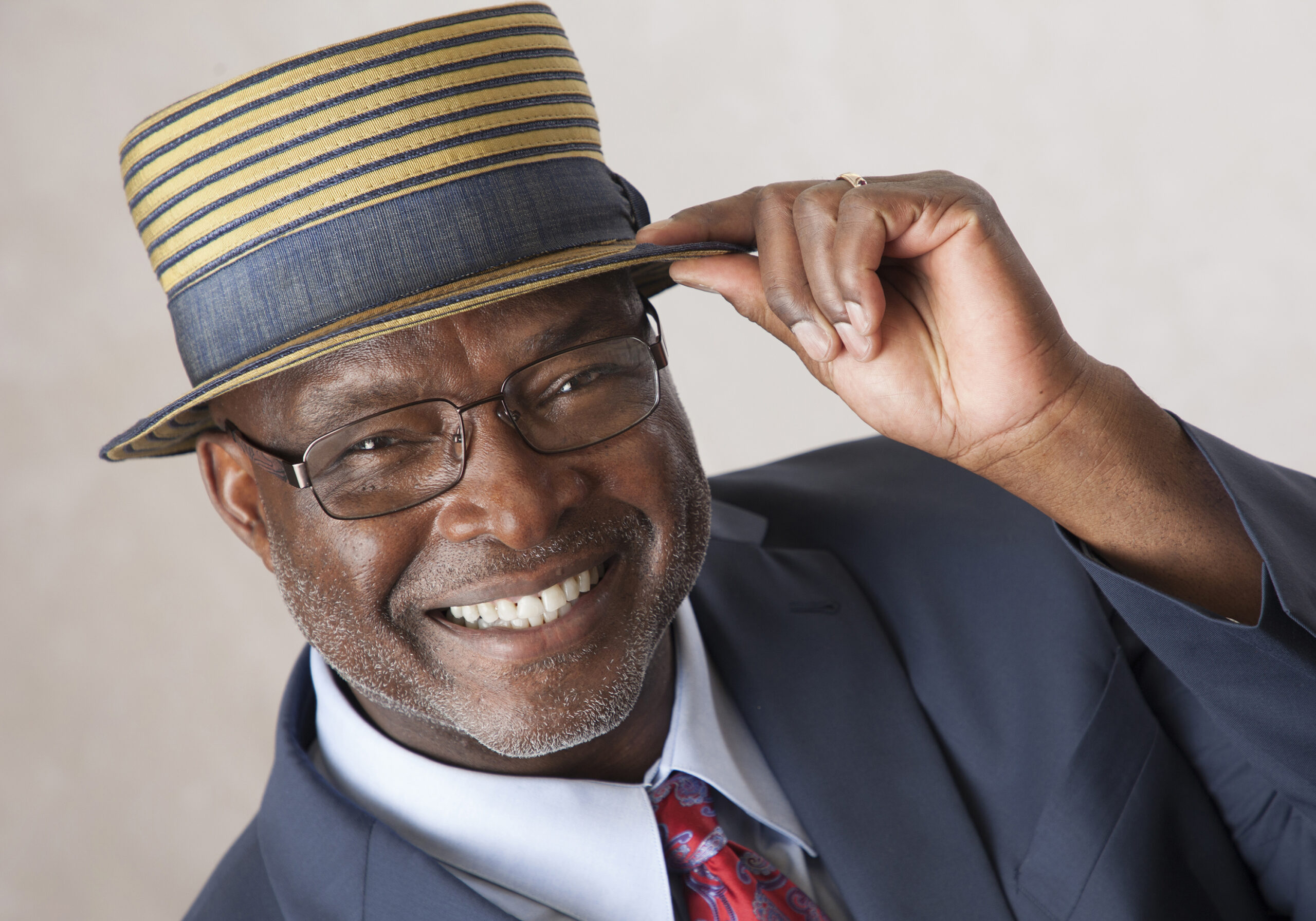
Clem Richardson is an award-winning newspaper reporter, editor, special projects writer and columnist. Clem has worked for six newspapers—the Anderson Independent, The Atlanta Journal-Constitution, The Chicago Sun-Times, The Miami Herald, New York Newsday and the New York Daily News—over the course of a three-decade career. He is a two-time winner of the New York City Press Club’s Father Mychal Judge “Heart of New York” Award, and received the New York Association of Black Journalists’ 2014 Lifetime Achievement Award. Clem is married and the father of three daughters. He lives in Brooklyn, N.Y.
Have you subscribed to theGrio podcasts “Dear Culture” or “Acting Up?” Download our newest episodes now!
TheGrio is now on Apple TV, Amazon Fire and Roku. Download theGrio.com today!
